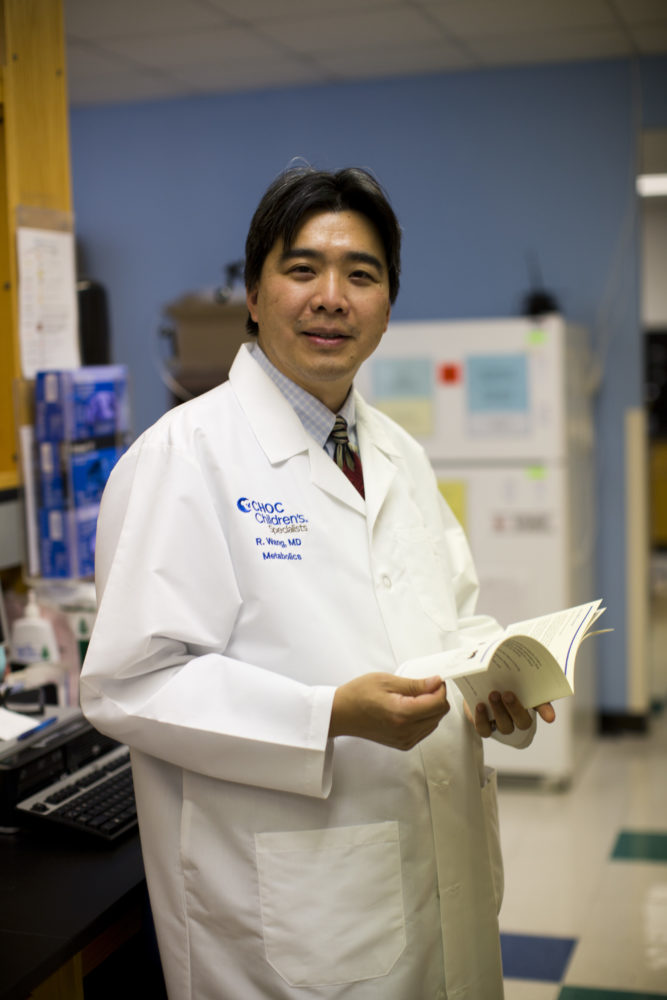Like most physicians, Dr. Raymond Wang got into medicine because he wanted to help. He wanted to be able to tell patients and their families that he could fix whatever was wrong with them.
When it comes to the disease Dr. Wang dedicated his career to studying, however, he can’t offer such assurances. Hopefully that day is coming.
Dr. Wang and his team at CHOC are participating in a clinical trial of a drug intended to treat a rare pediatric disease called MPS IIIA. It’s a type of Mucopolysaccharidosis, or MPS, a genetic condition that causes physical abnormalities in young children and causes them to lose their neurological development.
Also called Sanfilippo syndrome, its early symptoms can mirror those of autism, but unlike autism, the patients don’t improve, instead gradually deteriorating until memories and even basic abilities are lost. Most Sanfilippo patients don’t survive to adulthood.
There is currently no cure.
“When we go into medicine, we come in thinking, ‘All right, I’m going to help my patients. I’m going to make them better,’ ” says Dr. Wang, a clinical geneticist and biochemical genetics specialist at CHOC for the past 12 years. “When you are faced with the prospect that you can’t help, or at least in the sense that you can’t make these kids better and cure them, that doesn’t sit well with me.”

Phases II and III of the trial are being conducted by Lysogene, the French company that developed the experimental treatment. CHOC is one of four U.S. hospitals taking part; there are three such sites in Europe: in France, Germany, and the Netherlands. Lysogene is still enrolling patients and is seeking a total of 20.
Those patients are hard to find. In his decade of researching MPS and seeing patients, Dr. Wang estimates he’s only diagnosed 10 cases. Two of those children were siblings, and tragically both died of the disease. But Dr. Wang has enrolled one patient in the new trial.
Lysogene sought out Dr. Wang for the trial because of his expertise in researching and diagnosing the various MPS types. If the Lysogene drug is eventually approved by the FDA, CHOC should become the first facility on the West Coast to be able to both diagnose the disease and administer the drug, which is surgically inserted into brain tissue.
It won’t be apparent until a checkup about six months after the procedure whether the drug is working.
“We are hoping to prevent regression at the least, or allow for developmental progression,” Dr. Wang said.
There have been seven different types of MPS identified: I, II, III, IV, VI, VII and IX, not counting the subtypes within them. The subtype MPS IIIA, Sanfilippo, strikes about one in every 100,000 children.
MPS is an inherited disease. All the types are collectively known as “lysosomal storage diseases.” Lysosomes are compartments in cells that break down molecules and remove waste products.
Normally, different enzymes in the lysosomes break down complex sugars called glycosaminoglycans, also known as mucopolysaccharides. In MPS, glycosaminoglycans are not broken down because of a deficiency in one of those lysosomal enzymes. As a result, the glycosaminoglycans accumulate in the cells and cause tissue damage.
Physical symptoms can include thickening of the lips and skin, enlarged liver and spleen, hernias, recurring ear infections, joint pain and stiffness, and shortness of stature. With Sanfilippo, which attacks brain cells, cognitive impairment could include delayed speech. Since by itself speech delay isn’t uncommon in children, Sanfilippo’s initial symptoms only add to the confusion for families.
In the first two to three years of a patient’s life, “there might not be any symptoms,” said Dr. Wang, director of CHOC’s Foundation of Caring Lysosomal Storage Disorder Program . “Nobody ever thinks ‘my kid has Sanfilippo,’ and few doctors think about it. But it starts to be around 3, 4, 5, when hyperactivity starts, and there are questions of autism, and usually what happens is a physician recognizes that kids with Sanfilippo look a little different.”
A treatment that has shown success for some kinds of MPS is enzyme-replacement therapy: delivering synthetic working enzyme using an intravenous solution. It can reduce the effect of symptoms and improve quality of life. But the treatment only works if the disease is not located in the brain; unfortunately, the life-threatening symptoms of Sanflippo are caused by effects of the disease in the nervous system.
Inside the brains of children with Sanfilippo syndrome, a waste product called heparan sulfate builds up, causing nerve damage and, over time, the death of nerve cells. The Lysogene drug includes a package called a “vector.” It contains genetic instructions that enable treated nerve cells to make the missing enzyme, called sulfo-hydrolase, which clears out the waste product.
“Short-term, you can measure things like, is the body producing sulfo-hydrolase enzyme; is there a reduction in heparan sulfate?” Dr. Wang says. “But the more important thing is, is this actually helping these children? What parents really care about is, is it helping their child’s neurologic function. Is my child not regressing? Is my child maybe even gaining developmental milestones back?”
Dr. Wang acknowledges that, as a younger doctor, he was fascinated by the diagnostic side, the “sleuthing” part of identifying patients with, and researching, MPS. But over time, after accompanying many MPS patients and their families along difficult and tragic journeys, he knows his motivations now have a higher purpose, beyond intellectual stimulation.
He reflects that his involvement in clinical trials for children with neurodegenerative conditions such as the Lysogene study is “a way for me personally to channel my feelings of helplessness when we diagnose someone with a supposedly incurable condition.”
“I know how painful it is for these families,” Dr. Wang says. “If I can give them the possibility of hope, then that’s what makes waking up each morning and heading to work worthwhile.”
Learn more about referring to CHOC’s metabolic disorders specialists.




